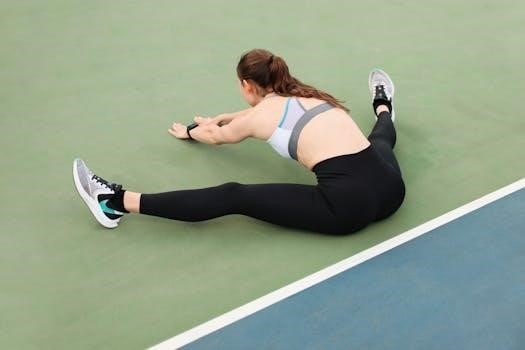
-
By:
- otis
- No comment
piriformis exercises pdf
Piriformis exercises are designed to target the piriformis muscle‚ located deep in the buttocks‚ and are crucial for improving hip flexibility‚ stability‚ and relieving sciatica symptoms.
Understanding the Piriformis Muscle and Syndrome
The piriformis muscle‚ a small but mighty player in hip function‚ resides deep within the buttocks‚ acting as a lateral rotator and stabilizer. This muscle’s significance is often overlooked until problems arise‚ leading to piriformis syndrome.
Piriformis syndrome manifests as pain‚ often deep and centralized in the buttocks‚ sometimes radiating down the back of the leg‚ mimicking sciatica. This occurs when the piriformis muscle irritates or compresses the sciatic nerve‚ which runs nearby or‚ in some cases‚ directly through the muscle.
Understanding the biomechanical origins of piriformis syndrome is crucial. Faulty movement patterns‚ such as overuse or strain‚ can trigger the syndrome. Furthermore‚ anatomical variations can predispose individuals to this condition.
Proper diagnosis is essential‚ as symptoms can overlap with other lower back or hip issues. Recognizing the piriformis muscle’s role and the factors contributing to its dysfunction is the first step toward effective management and relief.
Benefits of Piriformis Exercises
Piriformis exercises offer a multitude of benefits‚ primarily focusing on alleviating pain and improving functionality. Regular stretching and strengthening of the piriformis muscle can significantly reduce buttock pain and sciatica-like symptoms‚ enhancing overall comfort.
These exercises also promote increased hip flexibility‚ which is crucial for various activities. Improved flexibility allows for a greater range of motion‚ making everyday tasks easier and more comfortable. Furthermore‚ enhanced stability in the hip joint contributes to better balance and reduces the risk of injuries.
By addressing faulty movement patterns and muscle imbalances‚ piriformis exercises can correct underlying biomechanical issues. Strengthening surrounding muscles‚ such as the glutes‚ further supports hip stability and reduces strain on the piriformis.
Moreover‚ these exercises can improve blood flow to the area‚ promoting healing and reducing inflammation. Integrating piriformis exercises into a routine can lead to long-term relief and improved quality of life‚ making them a valuable tool for managing piriformis syndrome and related conditions.

Types of Piriformis Stretches
Several piriformis stretches can alleviate pain and improve flexibility. Common variations include supine‚ seated‚ and standing stretches‚ each targeting the muscle from different angles for optimal relief.
Supine Piriformis Stretch (Figure Four)
The Supine Piriformis Stretch‚ often called the Figure Four stretch‚ is a gentle and effective way to release tension in the piriformis muscle. To begin‚ lie on your back with your knees bent and feet flat on the floor. Next‚ cross your right ankle over your left knee‚ forming a “figure four” shape. Gently clasp your hands behind your left thigh and pull your left knee towards your chest.
You should feel a stretch in your right buttock‚ where the piriformis muscle is located. Hold this position for 20-30 seconds‚ breathing deeply. Repeat on the opposite side. This stretch can be modified by using a towel or strap to assist in pulling the thigh closer if needed. Regularly performing this stretch can help reduce pain and improve flexibility in the hip region.
Seated Piriformis Stretch
The Seated Piriformis Stretch is a convenient exercise that can be performed almost anywhere. Begin by sitting upright in a chair with your feet flat on the floor. Cross your right ankle over your left knee‚ ensuring your spine remains straight. Gently lean forward from your hips‚ maintaining a neutral back. You should feel a stretch in your right buttock‚ targeting the piriformis muscle.
To deepen the stretch‚ apply gentle pressure to your right knee‚ pushing it slightly downwards. Hold the stretch for 20-30 seconds‚ breathing deeply. Repeat on the opposite side. This exercise is particularly beneficial for individuals who spend long hours sitting‚ as it helps counteract the tightness that can develop in the piriformis muscle. Be mindful to listen to your body and avoid pushing beyond a comfortable range of motion.
Standing Piriformis Stretch
The Standing Piriformis Stretch offers a simple way to target the piriformis muscle while improving balance. Begin by standing with your feet shoulder-width apart. Cross your right ankle over your left knee‚ forming a figure-four shape with your legs. Gently bend your left knee‚ lowering yourself down as if sitting in a chair.
Maintain a straight back and engage your core for stability. You should feel a stretch in your right buttock. Use a wall or chair for support if needed‚ particularly when starting. Hold the stretch for 20-30 seconds‚ breathing deeply and evenly. Repeat on the opposite side. This stretch is beneficial for those who find seated stretches difficult or prefer a weight-bearing option. It can also help improve hip mobility and reduce tension in the piriformis muscle.
Piriformis Strengthening Exercises
Strengthening the muscles around the piriformis is vital for hip stability and function. Exercises like glute bridges and hip abductions can help improve strength and reduce pain.
Glute Bridges
Glute bridges are excellent for strengthening the gluteus maximus‚ which supports the piriformis. Start by lying on your back with knees bent at 90 degrees and feet flat on the floor. Keep your arms at your sides‚ palms down. Engage your core and glutes‚ then lift your hips off the floor‚ creating a straight line from your shoulders to your knees.
Squeeze your glutes at the top of the movement and hold for a few seconds. Slowly lower your hips back to the starting position. Make sure not to arch your lower back excessively. To increase the intensity‚ you can perform single-leg glute bridges by lifting one leg off the floor during the exercise. Perform 2-3 sets of 10-15 repetitions to build strength and stability.
Glute bridges help stabilize the pelvis and improve hip extension‚ indirectly benefiting the piriformis muscle by promoting balanced muscle activation and reducing strain. They also help in improving core engagement and overall lower body strength.
Hip Abduction Exercises
Hip abduction exercises are vital for strengthening the muscles on the outer hip‚ including the gluteus medius and minimus‚ which play a key role in hip stability. Weak hip abductors can contribute to piriformis syndrome by causing compensatory movements that strain the piriformis muscle.
A simple hip abduction exercise involves lying on your side with legs straight. Slowly lift your top leg towards the ceiling‚ keeping your knee straight and foot flexed. Avoid rotating your hip forward or backward. Lower the leg back down with control. You can add resistance by using a resistance band around your ankles.
Standing hip abduction can be performed by holding onto a chair or wall for balance and lifting one leg out to the side. Perform 2-3 sets of 10-15 repetitions on each leg. Strengthening these muscles helps maintain proper alignment and reduces stress on the piriformis.

Piriformis Exercises for Sciatica Relief
Sciatica‚ often characterized by pain radiating down the leg‚ can be significantly alleviated through targeted piriformis exercises. The piriformis muscle‚ when tight or inflamed‚ can compress the sciatic nerve‚ causing pain and discomfort. Specific exercises aim to relieve this compression.
Gentle stretching exercises‚ such as the supine piriformis stretch (figure four) and seated piriformis stretch‚ can help release tension in the muscle. These stretches should be performed slowly and deliberately‚ holding each stretch for 20-30 seconds.
In addition to stretches‚ strengthening exercises for the surrounding muscles‚ like the glutes and hip abductors‚ provide support and stability‚ reducing the likelihood of piriformis irritation. By incorporating these exercises into a regular routine‚ individuals can effectively manage and reduce sciatic pain associated with piriformis syndrome.

Proper Form and Precautions
Maintaining proper form during piriformis exercises is crucial to prevent injury and maximize effectiveness. Before starting any exercise program‚ consult with a healthcare professional‚ especially if you have pre-existing conditions or experience pain; Always begin with a gentle warm-up to prepare the muscles for activity.
When performing stretches‚ avoid bouncing or forcing the movement‚ as this can lead to muscle strains. Focus on controlled‚ deliberate motions and listen to your body‚ stopping if you feel any sharp or intense pain. Ensure that your posture is correct throughout each exercise to target the piriformis muscle effectively.
Pay attention to your breathing‚ exhaling during the stretch or exertion phase and inhaling during the relaxation phase. Progress gradually‚ increasing the intensity or duration of exercises as your strength and flexibility improve. If you experience persistent pain or discomfort‚ discontinue the exercises and seek guidance from a qualified physical therapist or healthcare provider.
Integrating Piriformis Exercises into a Routine
Incorporating piriformis exercises into your daily or weekly routine can significantly improve hip health and overall well-being. Start by identifying specific times in your schedule when you can dedicate 10-15 minutes to these exercises. Consistency is key‚ so aim for at least 3-4 sessions per week to experience noticeable benefits.
Consider performing piriformis stretches after a warm shower or light cardio‚ as this can help loosen the muscles and enhance flexibility. You can also integrate these exercises into your existing workout routine‚ focusing on them during cool-down periods to prevent stiffness and promote recovery.
Listen to your body and adjust the frequency and intensity of exercises based on your individual needs and progress. Over time‚ you may find that incorporating piriformis exercises becomes a natural and enjoyable part of your self-care routine‚ contributing to improved mobility and reduced discomfort in the hip and lower back.

When to Seek Professional Help
While piriformis exercises can be highly effective for managing mild to moderate symptoms‚ it’s crucial to recognize when professional medical advice is necessary. If you experience severe‚ persistent pain in the buttocks or down the leg that doesn’t improve with self-care measures‚ consult a doctor.
Seek professional help if you notice any signs of nerve damage‚ such as numbness‚ tingling‚ or weakness in the leg or foot. These symptoms could indicate a more serious underlying condition that requires medical intervention. Additionally‚ if your pain is interfering with your daily activities‚ such as walking or sitting‚ a healthcare provider can provide a comprehensive evaluation and develop a tailored treatment plan.
A physical therapist can also offer guidance on proper exercise techniques and help you address any biomechanical issues that may be contributing to your symptoms. Don’t hesitate to seek expert advice if you’re unsure about the best course of action for your specific situation.